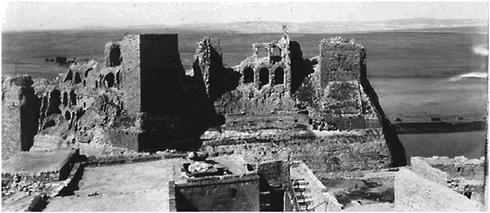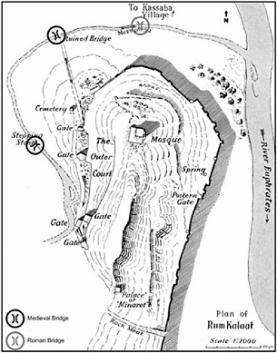Muslim Fortresses in the Levant: Between Crusaders and Mongols (104 page)
Read Muslim Fortresses in the Levant: Between Crusaders and Mongols Online
Authors: Kate Raphael
Tags: #Arts & Photography, #Architecture, #Buildings, #History, #Middle East, #Egypt, #Politics & Social Sciences, #Social Sciences, #Human Geography, #Building Types & Styles, #World, #Medieval, #Humanities


Figure 4.41
Al-Bīra, vaulted halls along the east and northeast
The fragmented inscription found in the galleries

(1) Our lord, the Sultan the most splendid king … ordered the building …
ordered the building …
The second reign of correlates with one of the most trying periods that the Mamluks knew. Ghazan led his armies for three consecutive years and was determined to cross the Euphrates and annex Syria to the Īlkhānid state. Although al-Bīra did not come under direct attack during this period and all the crossings were carried out much further south, the tension along the entire Euphrates frontier may have brought about this wave of building.
correlates with one of the most trying periods that the Mamluks knew. Ghazan led his armies for three consecutive years and was determined to cross the Euphrates and annex Syria to the Īlkhānid state. Although al-Bīra did not come under direct attack during this period and all the crossings were carried out much further south, the tension along the entire Euphrates frontier may have brought about this wave of building.
The water supply
Concerning the question of the fortress’s water supply, it is impossible to draw information from the survey of the site or the historical sources. Since al-Bīra is located on the bank of the river a well must have been built within the fortress grounds that reached the water level (this can be seen at al-Rūm); there may have also been cisterns to gather rain water. These were perhaps filled with rubble or buried during one of the several earthquakes that struck the region. There is no indication of their number or whereabouts or indeed of their existence.
al-Rūm); there may have also been cisterns to gather rain water. These were perhaps filled with rubble or buried during one of the several earthquakes that struck the region. There is no indication of their number or whereabouts or indeed of their existence.
Much of the evidence necessary to reconstruct the fortress is still missing, but by reconstructing the shell one can get a fairly good picture of what al-Bīra looked like. The construction and layout were well planned, the towers were closely positioned, leaving only short stretches of curtain wall between them. The western side of the fortress was protected by the river and the steep cliffs.
It is not surprising that the Mongol forces had difficulties in besieging the fortress. Only after breaching the town fortifications could the fortress be dealt with. Although
the town was of no great size, of the four Mongol attempts to conquer the site only the first, led by Hülegü, was successful. Later Īlkhānid armies failed miserably.
243
Lack of time was the main cause of failure. Breaching the city walls and moving on to besiege the fortress was an almost impossible undertaking in the time limits imposed by the defenders.
Returning to the thirteenth century landscape round al-Rūm
al-Rūm
 al-Rūm is located on the west bank of the Euphrates, approximately 40km north of al-Bīra, near the modern Turkish village of Halfeti.
al-Rūm is located on the west bank of the Euphrates, approximately 40km north of al-Bīra, near the modern Turkish village of Halfeti.
244
It is built on a spur that is “trapped” between two rivers; the Euphrates flows on the east, and the Merzuman curves round the northern and western slopes (
Figure 4.42
). Like al-Bīra, the fortress was built on a ford: a diagonal gravel bank is formed at the point where the tributary meets the Euphrates. This shallow section provided a convenient crossing point.
245
In 1260 it was one of the five fords chosen by the Mongols to cross the Euphrates on their first attempt to conquer Syria.
246
The Birecik dam, completed in 1999, changed the landscape considerably.
247
When I first visited the site in the summer of 2004, in order to reach al-Rūm I had to go by boat from the nearby village of Halfeti; it is a forty-minute
al-Rūm I had to go by boat from the nearby village of Halfeti; it is a forty-minute

Figure 4.42
